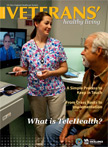Veterans' Healthy Living, Summer 2013
TeleDermatology
The TeleDermatology Program was launched many years ago—not for convenience, but because there were so few dermatologists in the rural areas of the VISN. VA Maine Medical Center in Augusta did not have a dermatologist on staff but had a large Veteran population in need of assistance. For a solution, the medical facilities worked together using a surrogate dermatologist model of care with a nurse practitioner directly interacting with patients. She would then transfer medical information to a specialist at Providence VAMC, and a dermatologist would provide direction for the nursepractitioner's management plan for the patient. This was complex because in 1997, when the process began, medical records were not electronic.
Technology for securely sending medical records electronically has since evolved, making the process more efficient. With advancements in the handling of images, photos of skin problems are now more easily transferred to a dermatologist at the Providence VAMC for review as well.
 Martin Weinstock, MD, Chief of Dermatology, Providence VAMC, said, "The first TeleDermatology program in the VISN was based on the surrogate dermatologist model. Now, there are multiple types of TeleDermatology programs available for Veterans."
Martin Weinstock, MD, Chief of Dermatology, Providence VAMC, said, "The first TeleDermatology program in the VISN was based on the surrogate dermatologist model. Now, there are multiple types of TeleDermatology programs available for Veterans."
With the advances in technology and the addition of programs, Veterans will find that no matter their location in VISN 1, access to top-notch skin care is now available.
Time Saving Tool for Diabetics
For diabetics, eye screenings are vital, as early detection of abnormalities can prevent serious vision damage and blindness in the worst cases. TeleRetinal Imaging is a telehealth "store-and-forward" process where an imager takes a picture of a patient’s retina at one location and sends the image to a reader, (optometrist or ophthalmologist) stationed at another location. In VISN 1,there are 16 conveniently located imaging sites. Once the image is taken, it is forwarded to Boston where a reader reviews it within three days.
In the past, patients traveled great lengths for regular eye exams, but with TeleRetinal Imaging, Veterans are able to visit a site close to them for risk assessment. Gerald Selvin, OD, Chief of Optometry, Boston Healthcare System, said that many times patients are not experiencing vision threatening conditions and therefore do not need to be seen by a specialist, so the process saves both patients and eyedoctors a great deal of time by avoiding unnecessary visits. "But there are cases where major retinopathy problems are indicated by the imaging," he said, "and appointments are scheduled promptly to ensure swift response to needs in such cases."
Nationwide, the VA began with 100 cameras for TeleRetinal imaging and screened roughly 16,000 Veterans the first year. Now, there are more than 600 cameras strategically located across the country that provide services to more than 250,000 Veterans each year.
What is Telehealth | IP Video into the Home | Caregiver Support and TeleRehab
TeleMOVE! and TeleMental Health | TeleDermatology and TeleRetinal

















